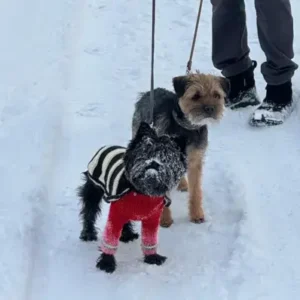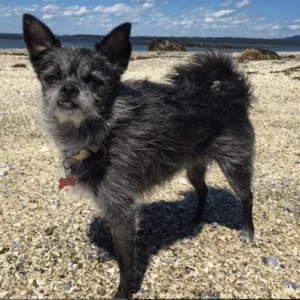Boston Terrier Pekingese Mix History/Origin
The Bostinese hybrid dog breed likely developed naturally over time, but designer breeders began intentionally crossing Boston Terrier with Pekingese dogs in the early 2000s, primarily in the United States.
Breeders were drawn to the spirited nature of the Boston Terrier and aimed to blend it with the Pekingese’s affectionate lapdog traits. As interest in these unique mixed breed pups grew, breeders continued to produce Boston Terrier Pekingese Mixes to meet the rising demand.
Boston Terrier Pekingese Mix Personality
Boston Terrier Pekingese Mix enthusiasts often describe these compact pups as spunky and affectionate. While they inherit some lapdog tendencies from their Pekingese side, they also carry a lively streak from their Boston Terrier lineage.
Intelligent and playful, Bostinese dogs keep their owners on their toes, often testing boundaries. Although they tend to bond closely with one “main person,” they are generally affectionate with all family members and even with strangers when properly introduced.
- Potential Challenges
The Bostinese is one of the dog breeds that can be stubborn and somewhat protective, making consistent training essential. While their loyalty and eagerness to please can aid in training, they require an energetic and patient owner.
Despite their playful nature, they don’t need extensive exercise or large spaces, making them suitable for both apartments and larger homes. However, they crave attention and do not handle being left alone for long periods, which could lead to behavioral issues.
Boston Terrier Pekingese Mix Physical Appearance
The Boston Terrier Pekingese Mix, or Bostinese, typically has a compact and sturdy build with a well-muscled body. They often inherit the expressive eyes and short muzzle of the Boston Terrier, combined with the distinct, slightly flattened face of the Pekingese. Their ears can vary, either standing upright like a Boston Terrier’s or flopping down more like a Pekingese.
- Size
The Boston Terrier Pekingese Mix, or Bostinese, is a small dog that blends traits from both parent breeds. These dogs usually have a muscular build, weighing between 7 to 14 pounds and standing about 9 inches tall.
- Coat color
Their coat can feature a variety of colors and patterns, with white, brown, and black being the most common. The coat may be solid, speckled, merle, or a combination of these. As a mixed breed, the appearance of a Boston Terrier Pekingese Mix can vary widely, depending on which traits they inherit from their Boston Terrier and Pekingese parents.
Brindle Boston Terrier Pekingese Mix- Source: carolinagirl_life
Black and White Boston Terrier Pekingese Mix- Source: theadventuresoffinntheboston
Boston Terrier Pekingese Mix Gender Differences
Both male and female Boston Terrier Pekingese Mixes show little to no difference in appearance. They share similar physical traits, including build, facial features, and overall size, making it difficult to distinguish between the genders based on looks alone.
Boston Terrier Pekingese Mix Feed/Nutrition
An ideal diet for the Boston Terrier Pekingese Mix should be designed for a small breed with moderate energy levels. To prevent weight gain, maintain a consistent feeding schedule and avoid leaving food out throughout the day. Also, limit the number of treats given.
Dietary needs will evolve from puppyhood to adulthood and into their senior years. For personalized advice, consult your veterinarian, as dietary recommendations will vary based on factors like weight, energy, and overall health.
Shrimp can be a healthy treat for your dog when served in moderation, but always remove the shells and avoid seasoning.
Boston Terrier Pekingese Mix Health
The Boston Terrier Pekingese Mix may be prone to some of the same health conditions as its parent breeds. Although many are generally healthy, they can be susceptible to certain issues, making regular veterinary checkups and good care essential for their well-being.
- Eye Health Issues: Boston Terrier Pekingese Mixes may be prone to eye issues due to their prominent eyes and facial structure. Conditions such as dry eye, conjunctivitis, cataracts and corneal ulcers can occur and may require regular veterinary check-ups.
- Patellar Luxation: This condition, where the kneecap dislocates or moves out of its normal position, can be a concern. Patella luxation can cause discomfort and affect mobility, so regular monitoring and veterinary care are essential.
- Brachycephalic Obstructive Airway Syndrome: As a breed with a short muzzle, the Bostinese is at risk for BOAS. This syndrome affects the airways, leading to breathing difficulties and potential respiratory issues that may require medical attention.
Boston Terrier Pekingese Mix Care and Grooming
Regular veterinary checkups are essential for your Boston Terrier Pekingese Mix to detect health issues early. Your vet can help establish a care routine to keep them healthy. Bostinese dogs require at least 30 minutes to an hour of daily exercise, including walks and play sessions, to manage their high energy and prevent weight gain.
Daily ear checks and cleaning are important, as is trimming their nails once or twice a month—your groomer can assist. Brush their teeth daily to prevent dental problems; your vet can guide you on proper brushing.
Bostinese dogs shed moderately to heavily and are not ideal for allergy sufferers. Their coats are easy to groom—brush weekly for shorter coats and biweekly for longer ones.
They are not suited for extreme weather, so provide a coat in winter and sunscreen in summer for exposed areas. Training your dog to stay is an essential command for their safety and can help reinforce good behavior during feeding times and other activities.
Boston Terrier Pekingese Mix Rescue Groups
Finding a Boston Terrier Pekingese Mix at a rescue group can be challenging due to its rarity. It’s often more effective to check with rescue organizations dedicated to the parent breeds—Boston Terriers and Pekingese—as they may have mixed breeds or be able to assist in locating one. These breed-specific rescues can offer valuable resources and connections for finding a Bostinese in need of a home.
Boston Terrier Pekingese Mix Price
The price of a Boston Terrier Pekingese Mix typically ranges from $500 to $1,500, depending on factors such as breeder reputation, pedigree, and location.
Finding a Boston Terrier Pekingese Mix for sale can be rare due to the breed’s limited availability. It’s advisable to seek out reputable breeders who specialize in Boston Terriers and Pekingese, as they may occasionally have mixed breeds or can refer you to someone who does.
Interesting Facts
- Despite their small size, Bostinese dogs have a surprisingly sturdy build, making them resilient and versatile pets suited for various living environments.
Best For
The Boston Terrier Pekingese Mix is ideal for individuals or families who appreciate a small, energetic dog with a playful and affectionate nature. They thrive with owners who can provide regular exercise, mental stimulation, and attention, making them well-suited for active urban dwellers or those with moderate-sized homes. They are not recommended for those with severe allergies or those who cannot commit to regular grooming and care.
Top Names
| Male Boston Terrier Pekingese Mix Names | Female Boston Terrier Pekingese Mix Names |
| Max | Bella |
| Milo | Daisy |
| Rocky | Lucy |
| Oliver | Lily |
| Charlie | Sophie |









 Boston Terrier- Source:
Boston Terrier- Source:  Pekingese – Source:
Pekingese – Source: 

 Brindle Boston Terrier Pekingese Mix- Source:
Brindle Boston Terrier Pekingese Mix- Source:  Black and White Boston Terrier Pekingese Mix- Source:
Black and White Boston Terrier Pekingese Mix- Source: 







